Picture a ute. What’s the first one which comes to mind? You might have thought of a Toyota Hilux, or maybe a Ford Ranger? Perhaps a Nissan Navara?
If you first thought of the Isuzu D-Max, I’d be willing to bet that you’re in the minority.
The D-Max has always flown under the radar in New Zealand. It’s never been a ute to vie for the top sales score, like the Toyota Hilux and Ford Ranger, both of which are currently topping the sales charts in New Zealand at time of this writing.
Yet Isuzu is not a small fish in a big sea. The company has been around nearly a century, primarily producing commercial vehicles and diesel engines, many of which end up around the globe in different formats and applications.
Those that the Isuzu D-Max, appreciate the ute for being a robust working ute, offered cheaper than the mainstream crowd.
So, why hasn’t the D-Max caught on? Well, it actually has.
The D-Max has been around in New Zealand since 2003, where it was sold in the form of the Holden Rodeo. It later became the Holden Colorado, before Isuzu began selling the D-Max alongside the Colorado in 2008.
Even today, the D-Max still wears a number of different badges across many different markets, including the new Mazda BT-50.
For the third generation D-Max, Isuzu appears to have a different strategy for the Australasian markets. The new D-max aims to spar with Hilux and Ranger on quality, comfort and safety. As a result, the price has substantially inflated too.Before we continue onwards into the rest of this review, the reader should note that the Mazda BT-50 is, for all intents and purposes, an Isuzu D-Max. The BT-50 is even made at the same Isuzu factory in Thailand. This is important to note, as we will be referring to BT-50 in many cases during the review. Our full review of the BT-50 can be found here.
Having recently been impressed with the Mazda BT-50, I was keen to test out the D-Max. Let’s determine if the original is better than the cover.

What’s In The 2021 Isuzu D-Max Range?
Unlike the BT-50, the D-Max range is more diverse within New Zealand, offering up to 9 different configurations.
This includes a 4WD single cab, two 4WD space cabs (extended-cab), two 2WD double-cabs, and four 4WD double-cab options.
The cheapest D-Max LX (2WD double cab) starts at $49,990. The 2WD LS starts at $54,490, and the 4WD LS-M and 4WD LS start from $61,990 and $65,990, respectively. Our test vehicle is the X-Terrain, which tops the Isuzu range at a price of $75,490.
The base 4WD double-cab, the LX, offers features such as 17’’ steel wheels, a 7’’ infotainment with 4-speakers, reversing camera, Apple CarPlay and Android Auto, 4.2’’ LCD dashboard display, automatic headlamps with auto high beams, rain sensing wipers, front and rear USB ports, cloth seats and Isuzu’s Intelligent Driver Assistance System (IDAS).
IDAS, which is standard for all models, features over 20 different safety technologies, including rear cross traffic alert, trailer sway control, lane departure warning, blind spot monitoring, adaptive cruise control, and hill descent control.

Step up to the X-terrain and you can expect features such as 18’’ alloys, a 9’’ infotainment with 8-speakers, SatNav, leather seats, leather steering wheel, 8-way power adjustable driver’s seat, proximity keys with push button start, dual zone climate control, LED running lights and auto levelling headlamps, side steps, front parking sensors and remote engine start.
The D-Max range is powered by a 3.0-litre, 4-cylinder turbo-diesel, pumping out 140kW of power and 450Nm of torque. This can be paired with either a 6-speed automatic gearbox, or with a 6-speed manual, which is available on six of the nine specs (the base 2WD LX, the Space Cab LS and the X-terrain miss-out on the manual).
Braked towing capacity is 3,500kg, while the tray payload can take up to 1,320kg (lowest offering is 970kg). 4WD models receive a rear locking differential, plus the usual switchable 2H-4H and 4L (low-range) gearing settings.
You can have your D-Max in seven different colours, being Blue, Red, White, Grey, Silver, Black and Orange.
For more information on the D-Max range, visit the Isuzu New Zealand website.
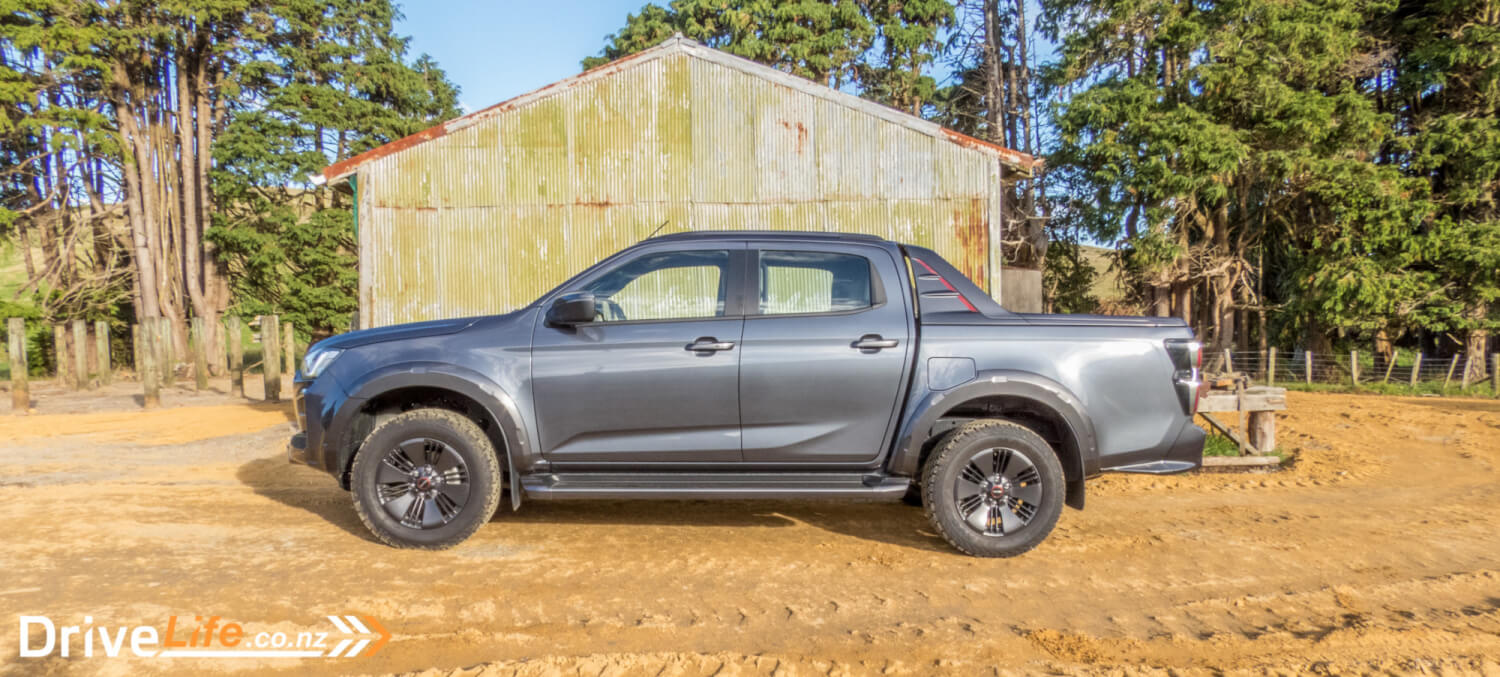
First Impressions Of The 2021 Isuzu D-Max X-terrain
To my eyes, the D-Max is easily one of the best looking new utes available. It’s all in the face, really. The LED lights, the pointed grille and prominent jawline really give this ute a tough aesthetic.

Beyond the face, it’s all fairly standard ute as you move towards the rear. There’s nothing too special happening, but design is constrained by the ute body. That said, the rest of the design is pleasant; all of the dimensions are right, and there are no inappropriate lines or angles.
Then there’s the X-terrain spec, adding a lift, extra exterior cladding, a blacked-out grille, roof-rails, sports bar and 18’’ alloys.
The result? It looks the business.
Of all the details, the one I wasn’t so big on was a small detail on the sports bar. It has these cheap red stickers to give flair to the bar, or something-er-rather (I didn’t read the marketing bumf). Fortunately, it’s one of those ‘up close’ qualities, as it looks fine from a distance.
Overall, the X-terrain is a damn fine-looking machine. Nice work, Isuzu.
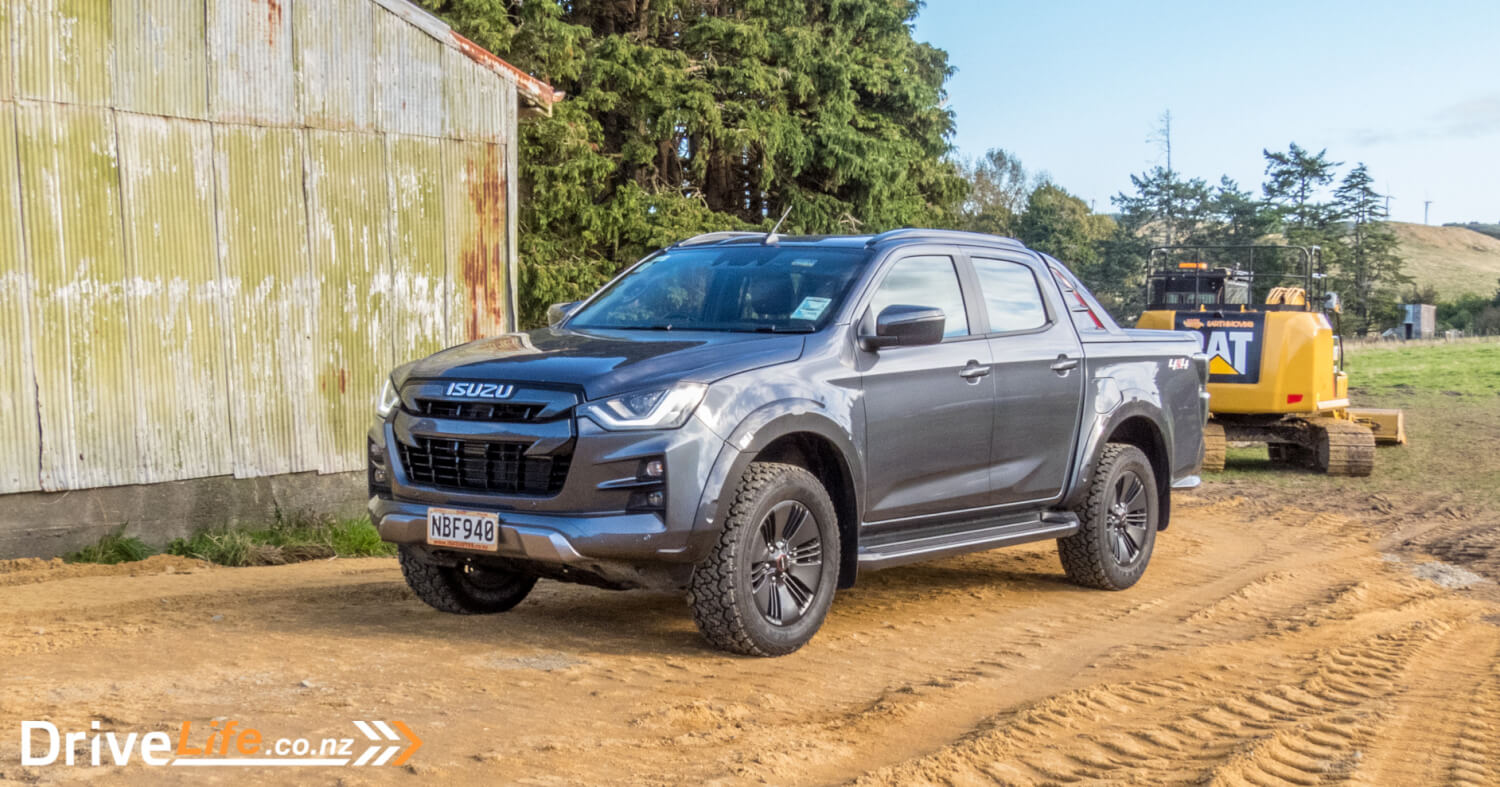
What’s The Interior Of The 2021 Isuzu D-Max X-terrain Like?
When I mentioned that the D-Max and the Mazda BT-50 are essentially the same, I meant it.
Climb inside the D-Max, and virtually everything from the seats, dashboard layout, infotainment screen, instrumentation, gearstick, steering wheel, climate controls, and more, are shared between both utes.
For more thoughts of the interior, check out the BT-50 review.
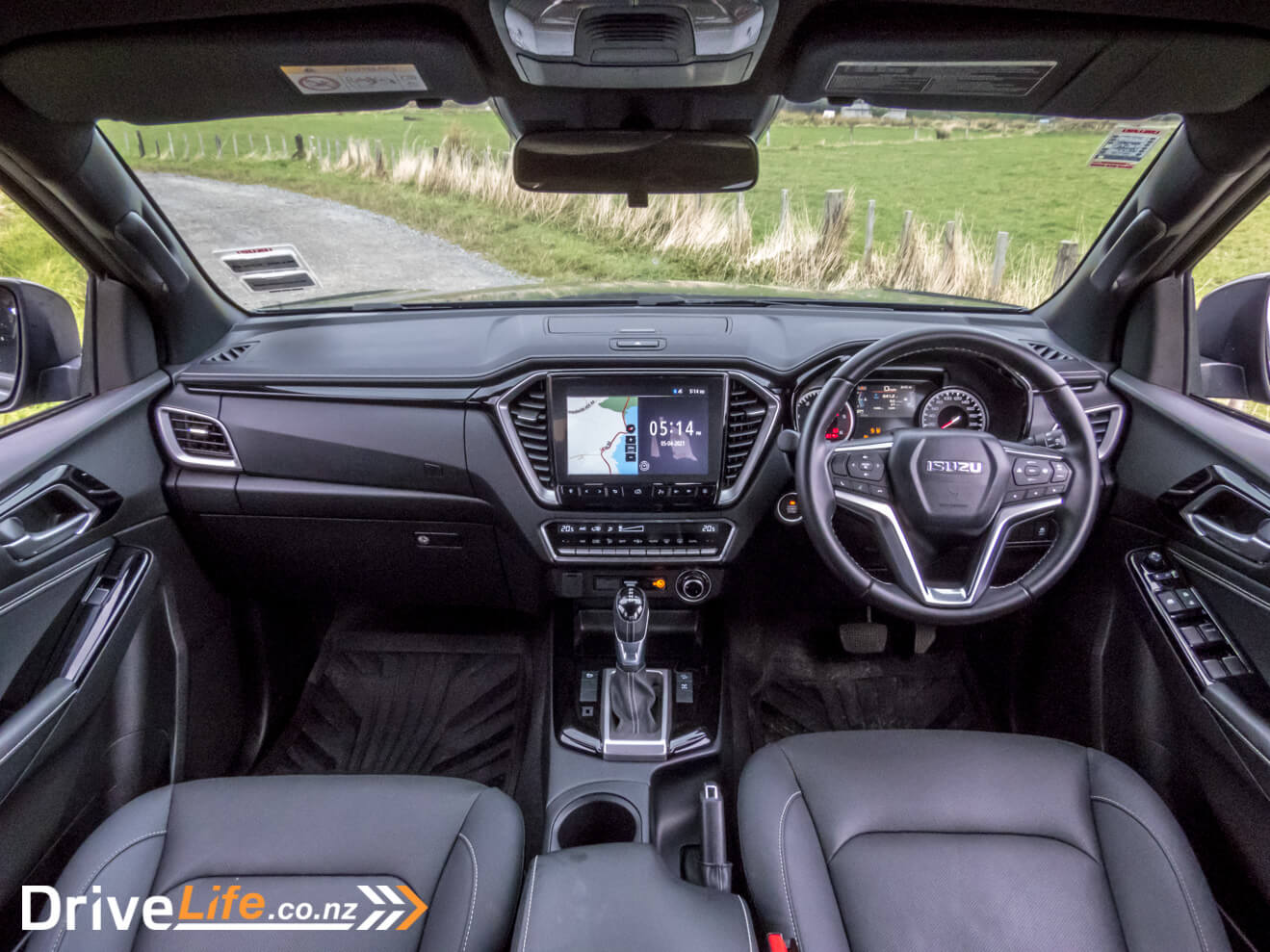
Although this isn’t just a straight cut-and-paste job from the manufacturers. There are a few differences between the two models.
First-off, the dashboard. It’s the same design and layout, though the D-Max benefits from additional storage spaces. There’s an additional cubby atop the dashboard, plus there’s two pop-up cup holders on each side of the dash.
Also, the entire top of the dash is layered with soft touch materials. I’d complained that the BT-50 only gave you a small strip of leather on the front of the dash, giving you the illusion of quality. The D-Max goes the whole way. Good start.
Although that’s virtually the end of the differences, aside from colours and trim patterns. Our D-Max had a full black leather interior, whereas the BT-50 uses a combination of brown and black materials, which is a colour scheme Mazda has been using as of late.
So we know they’re virtually the same, but that’s not a negative thing. I had tested the BT-50 Limited before driving the D-Max, and I mostly enjoyed the interior experience of the BT-50.
Everything inside is well constructed; the design is crisp, all the ergonomics are good, and there’s plenty of nice materials used. Construction wise, my only major complaints were with the lack of a driver’s footrest, plus the handbrake sounds like you’re grinding plastic together when applying it.
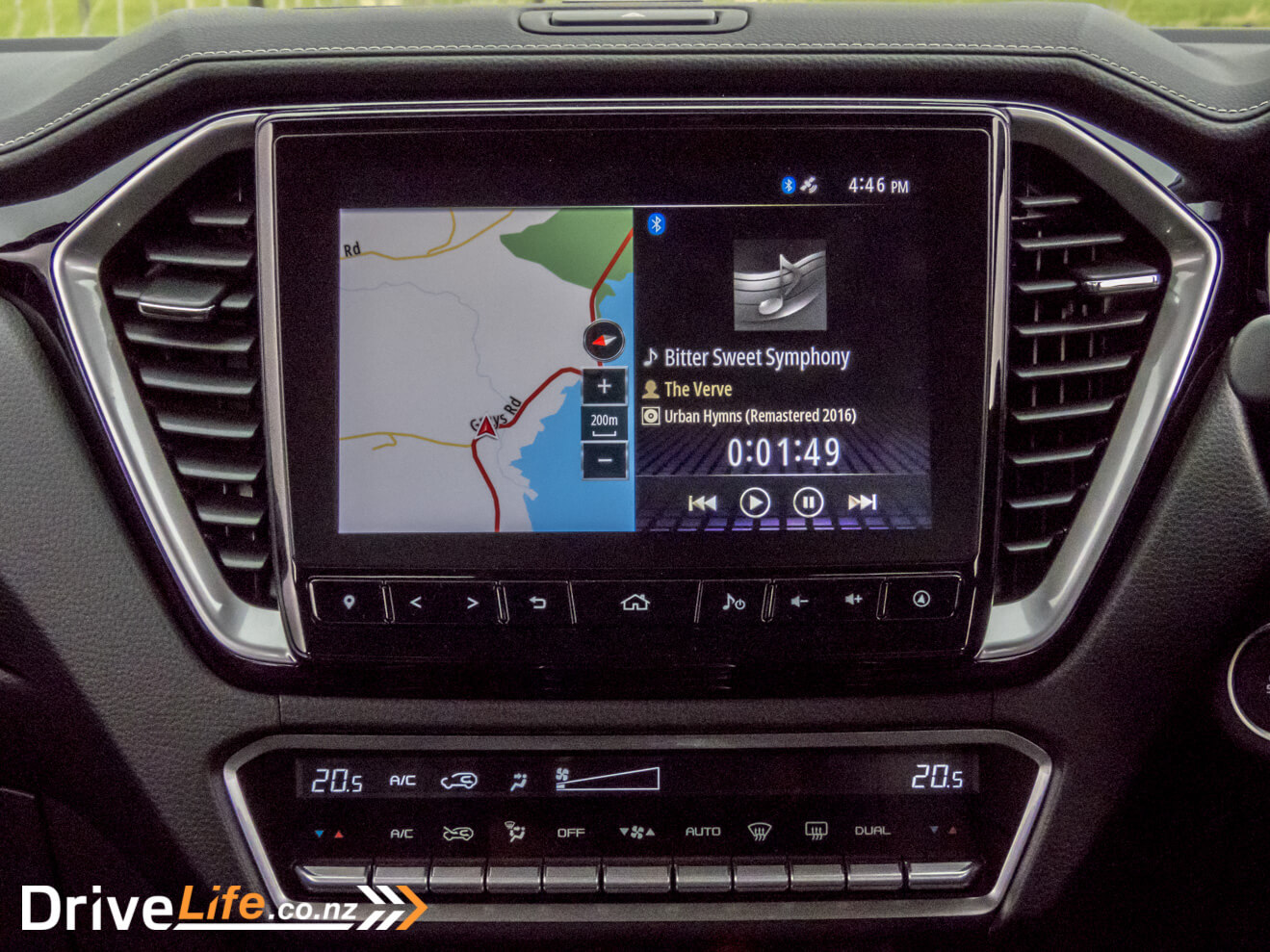
Front and centre of the dash is a 9’’ infotainment screen, which again, is shared with the BT-50. Plenty of those in the automotive media have complained about the infotainment system, arguing that it’s too slow or glitchy.
I’ll admit, by 2021 standards, it is a bit slow. But, it’s really not that bad. It’s also quicker if you use the physical shortcuts. Of course, the responsiveness does get frustrating if you’re trying to adjust something on the move, which you probably shouldn’t be doing anyway.
Overall, my experience of it wasn’t so bad at all. Bluetooth pairing works well, and there’s even wireless Apple CarPlay. Like any system, there’s a learning process involved, but it’s reasonably easy to pick-up.
The system is also connected up to an 8-speaker system, including speakers housed on the roof directly above your head. The sound quality from these speakers is decent, and probably the best I have experienced from any new ute recently tested.
My primary complaint with the infotainment was the fact that every action, including turning down the volume, had an accompanying ‘beep’. It’s totally unnecessary, but common sense prevails, and Isuzu allows you to mute it.
The instrument panel in front of the driver is also a strong point. The cluster display has plenty of info and configurable screens.
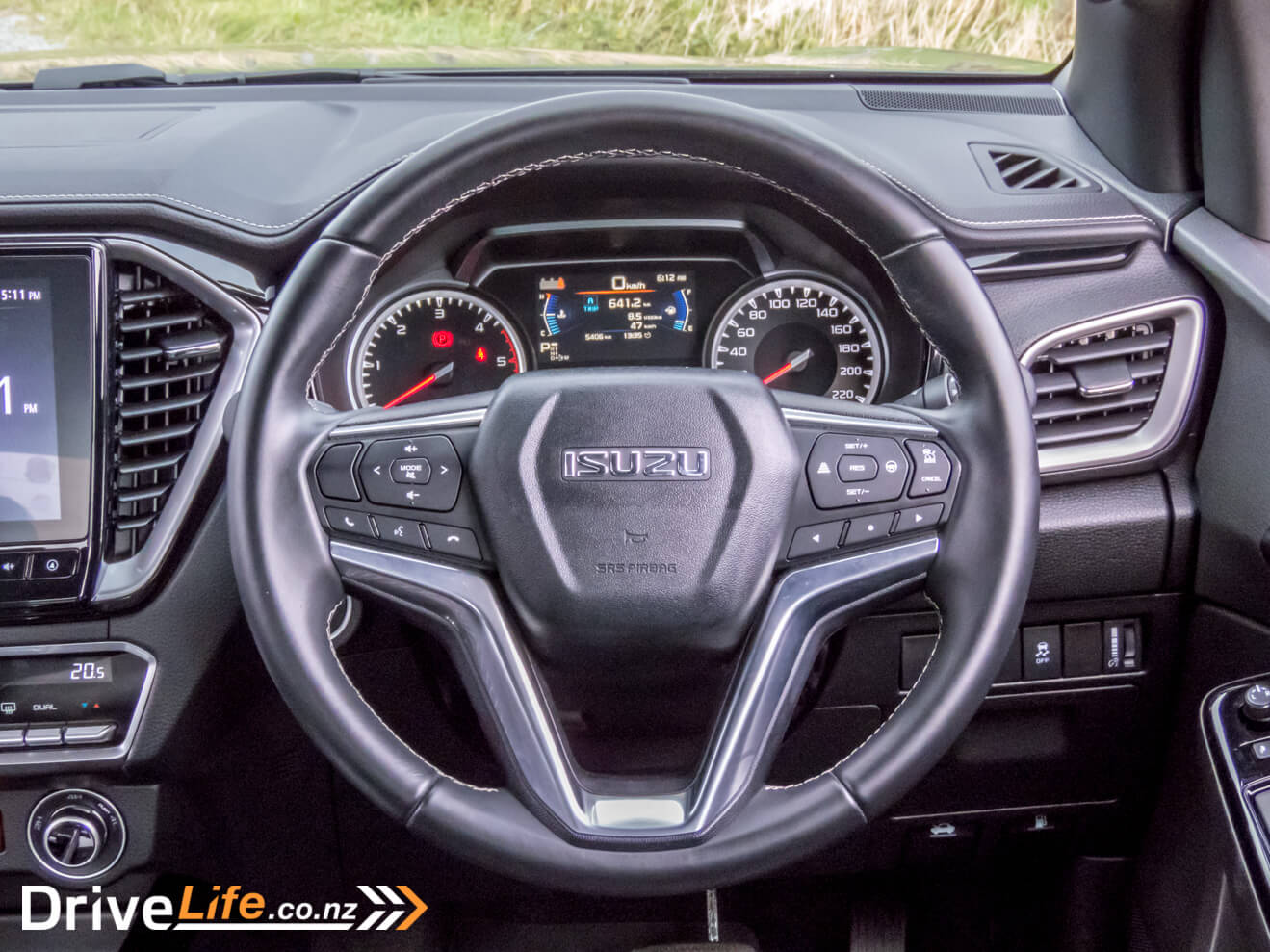
The 8-way power driver’s seat is nicely configurable, though I do have a slight complaint about the shoulder bolstering. The bolstering protrudes unusually far forward, which felt a tad awkward for my wide shoulders at first. Granted, I wouldn’t say I represent the majority here. Many others that tried the front seats sat in it comfortably.

The rear seats are a strong point of the D-Max cabin. There’s plenty of legroom, and the seats are comfortable by ute standards. There’s even a USB port in the back and a hook on the back of the passenger’s seat for hanging a shopping bag. They’re useful, because there’s no boot for groceries in a ute, unless you use the under-seat storage.
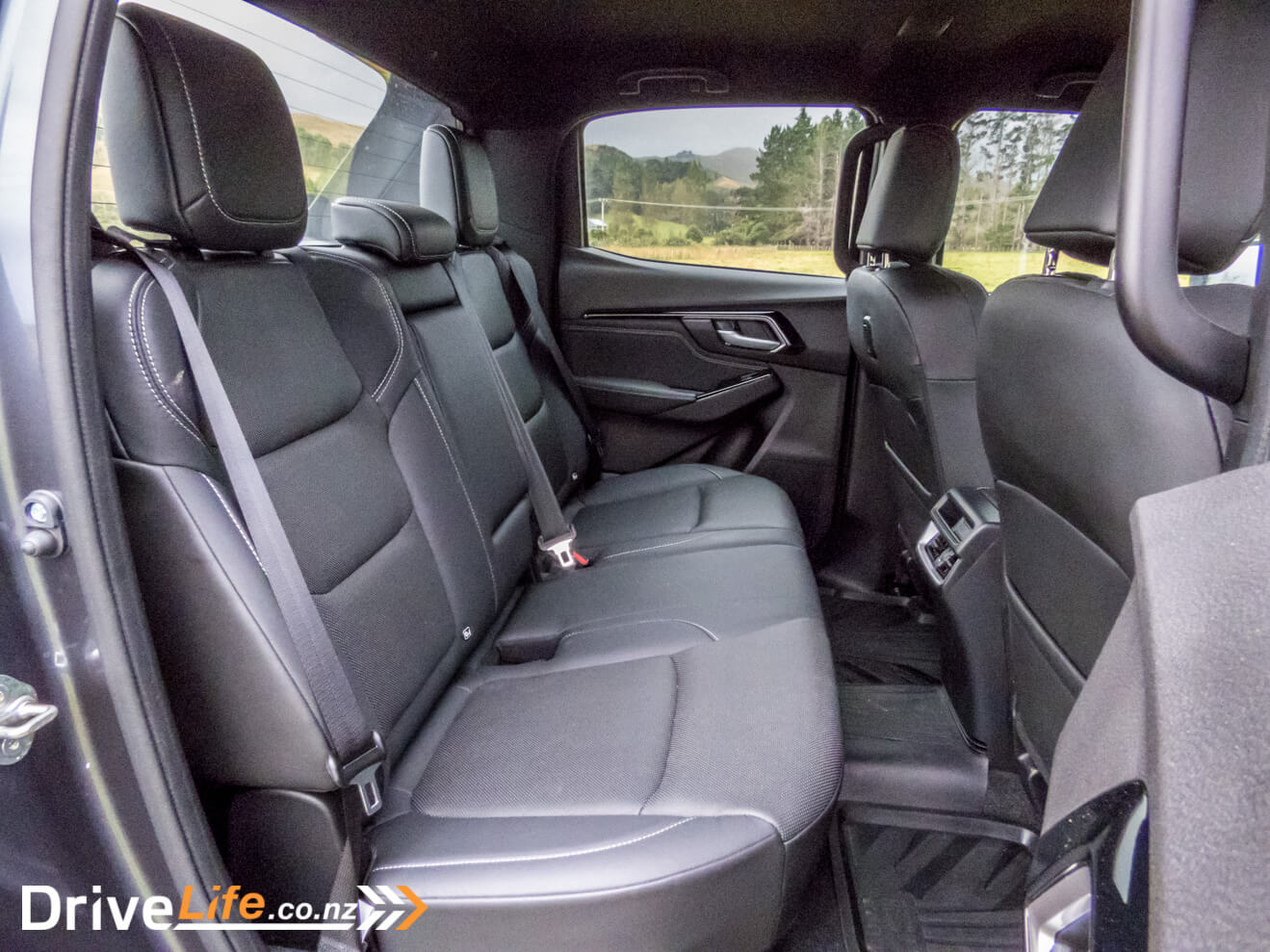
Returning to the front, the steering wheel has a blank switch on it. This seems odd for a top-spec vehicle, particularly one with a $75,490-price tag. The same blank is also on the top-spec BT-50. Which bears the question, what feature are we missing out on in New Zealand?
Speaking of missing out, this D-Max has a fair few blank switches about the place. It’s missing heated seats which are standard on the BT-50 Limited. In fact, there’s a few interior features missing from the top-spec D-Max, which the Mazda does get. This doesn’t seem so bad, until you realise that the BT-50 is cheaper than the D-Max. Sure, one may argue that the Limited is more likely to go up against the D-MAX LS, but the BT-50 is cheaper than that one too. This is a big problem for the D-Max. You can essentially get the same vehicle with more features, just wearing a different badge, for less. I’ll go into details further down in the article.
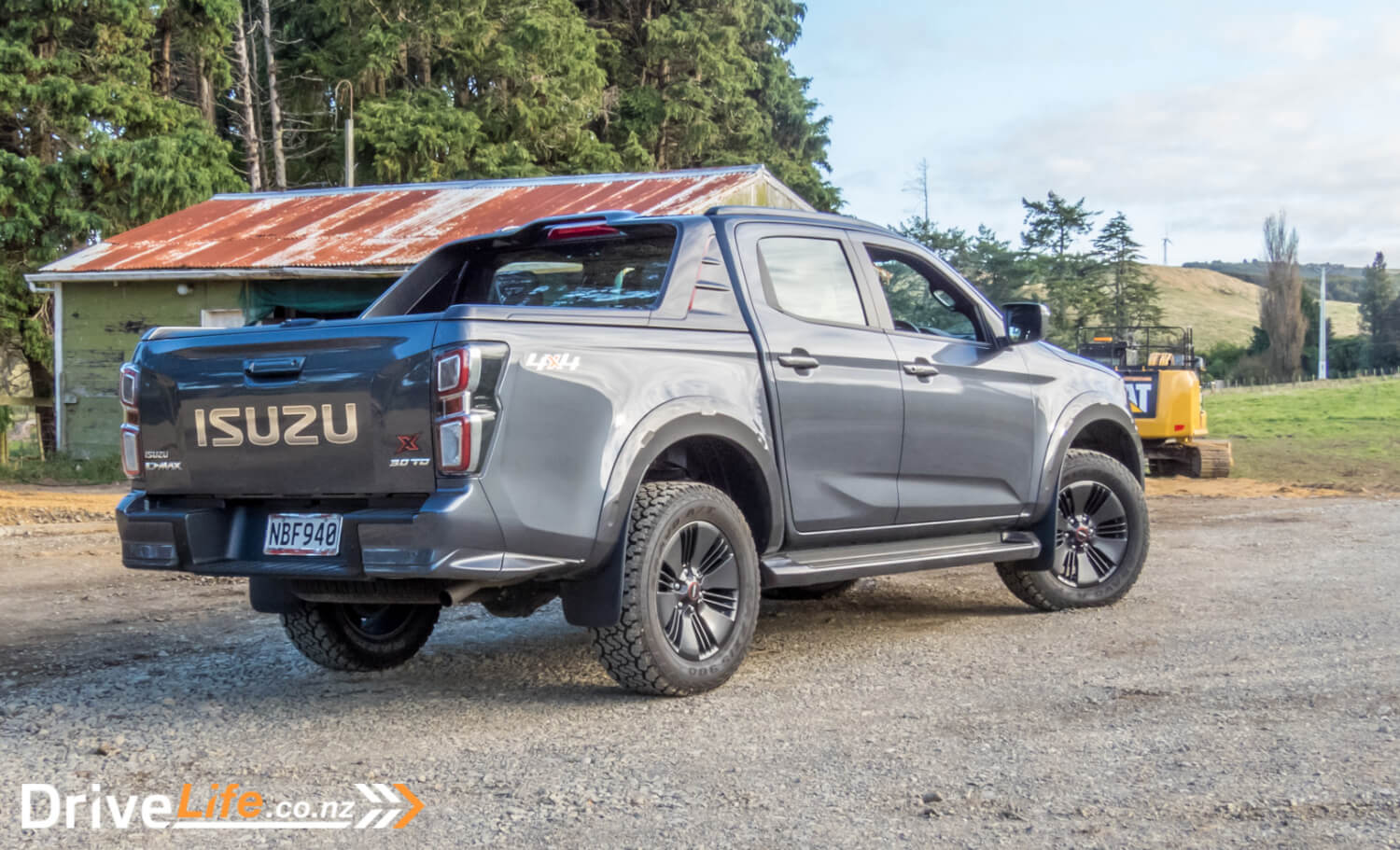
The Drive
Underneath the bonnet of the D-Max is a 3.0-litre 4-cylinder turbo-diesel, producing 140kW of power and 450Nm of torque. On the X-terrain, it’s paired with a 6-speed automatic gearbox.
Peak torque is accessed from around 1,600rpm to 2,600rpm, meaning there’s a healthy low and mid-range. Power delivery is smooth and linear, and the ute doesn’t feel overly exerted when you push it higher into the top-end.

The 6-speed auto transmission is excellent, shifting seamlessly between gears and blending the power curve together nicely. It really shows that you don’t need any more than 6-gears to achieve this.
Yet, the biggest highlight is the fuel economy. We drove the D-Max on a blend of motorway, inner city and rural roads. At the end of our test, we achieved a fuel economy result of 8.5L/100kms over 600kms of driving, which is close to the claimed figure of 8.0L/100kms. We also got a similar result with the BT-50 when tested, achieving 9.0L/100kms. That ute saw more time in the city, hence the higher number. This is honestly quite impressive, as many turbo-diesel utes I’ve tested run well into the 10.0L/100kms range.
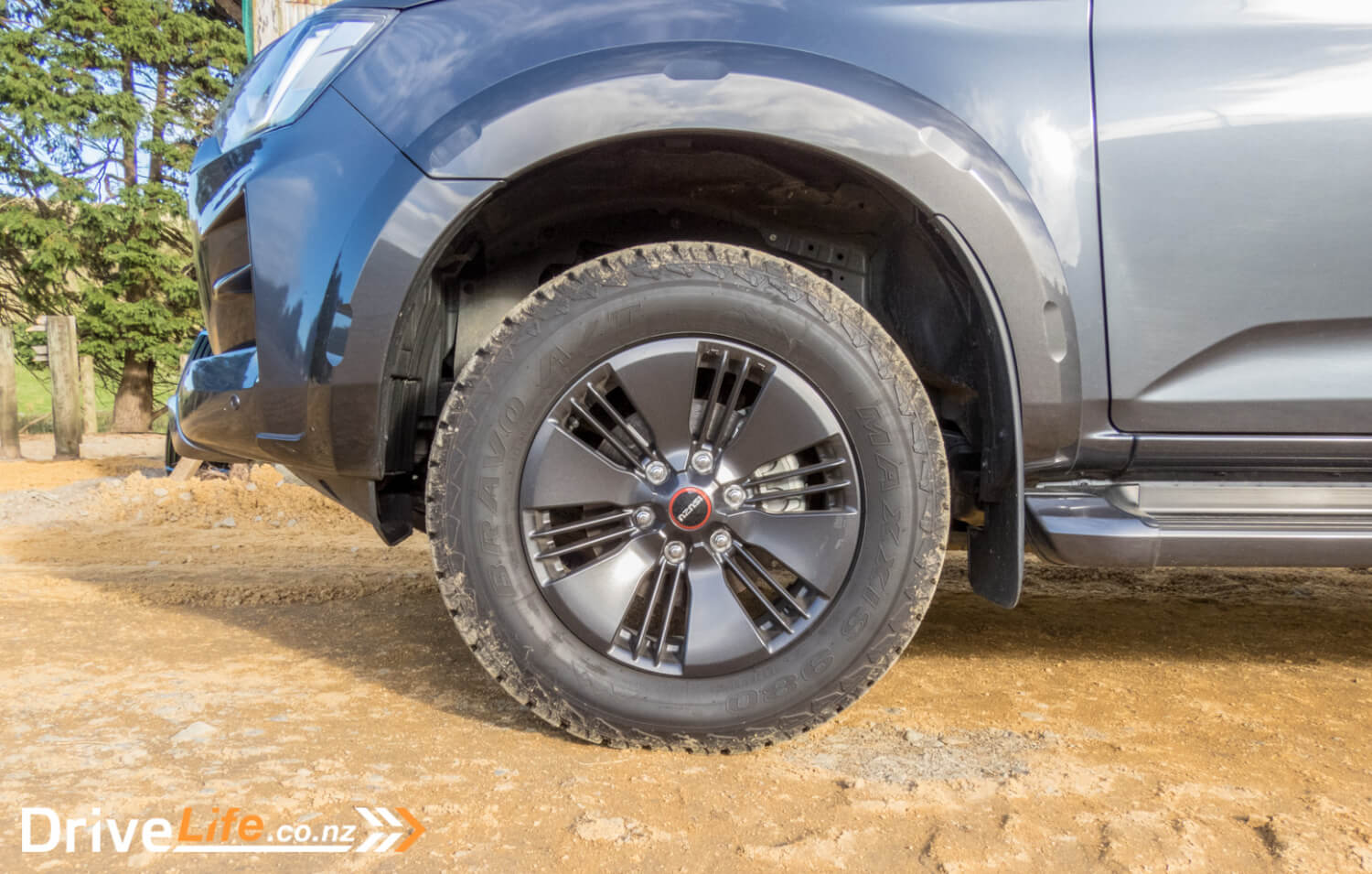
Utes never have performed well on ride quality, mainly due to their construction consisting of a ladder frame chassis and rear leaf springs. It’s designed to be used for off-road driving and working outdoors, not for achieving ultimate comfort. This said, the D-Max’s ride quality was rather good by current ute standards. It’s perfectly liveable for the day-to-day.
At times, the ride of the D-Max did feel marginally different to the BT-50, but I’d put this down to the tyres. The D-Max had a pair of Maxxis Bravo 980 AT’s, whereas the BT-50 wore Bridgestone Duellers. Both tyres are good, but serve different purposes. I did note that the on-set of tyre sequel occurred later in a corner in the D-Max, relative to the BT-50.
As acknowledged in the BT-50 review, the suite of driver’s technology has plenty of quirks and is a tad too active at times. Firstly, the traffic sign recognition software beeps each time you exceed the recognised speed limit, which I found a tad annoying. Fortunately, you can switch it off.
The next was the adaptive cruise control. It will operate down to a halt, but will self-cancel after stopping, which is a pain. The systems that can start and stop are fantastic in heavy traffic, hence this is a missed opportunity by Isuzu.
The last is the lane keep assist – it’s default setting is a smidgen too active for my preference.
Overall, the quirks of these systems only fall on the mildly annoying side of the spectrum. None of them are complete dealbreakers, and they’re ultimately there to support the Isuzu with its strong ANCAP safety score.

The problem
As we’d mentioned earlier, the biggest sticking point for the Isuzu D-Max line-up is that most of the double-cab trim levels have comparatively fewer features and are more expensive than its Mazda BT-50 equivalent.
For example, take the two top-spec models, the Isuzu X-terrain and the Mazda BT-50 Limited. The BT-50 has heated seats, an auto-dimming rear-view mirror, and a few more interior features. The price difference between the two? The X-terrain is $14,500 more expensive!
How? Well, I suppose the X-terrain has different off-road tyres, all the exterior trimmings and the retractable tray lid. But that’s pretty much it. And I know what you’re thinking, there’s got to be some fundamental difference between the two justifying the price difference. You’d be wrong.
I suppose once you start adding accessories, that price difference will narrow. The D-Max X-terrain is fully loaded with those aforementioned accessories, while the BT-50 Limited simply doesn’t offer them yet. That said, I doubt you’d even get close to 14k if you were to adorn the BT-50 with the same items once they’re made available.
So why would Isuzu not price themselves competitively? Why would they even allow their own ute to be sold cheaper under another brand?
From what I can work out, the answer is simply within the accounting. Mazda offers a much larger range in New Zealand. Therefore, they can distribute their margins across multiple vehicles models, bringing the overall unit cost downwards. This allows them to price the BT-50 cheaper, enticing sales while still gaining a margin. Isuzu, on the other hand, only sells the D-Max. They can’t use the same strategy.
Anyway, this is the only viable reason that actually makes sense for the cost difference between the two utes. If I’m wrong (and that is entirely plausible), we’d appreciate it if Isuzu could correct us.
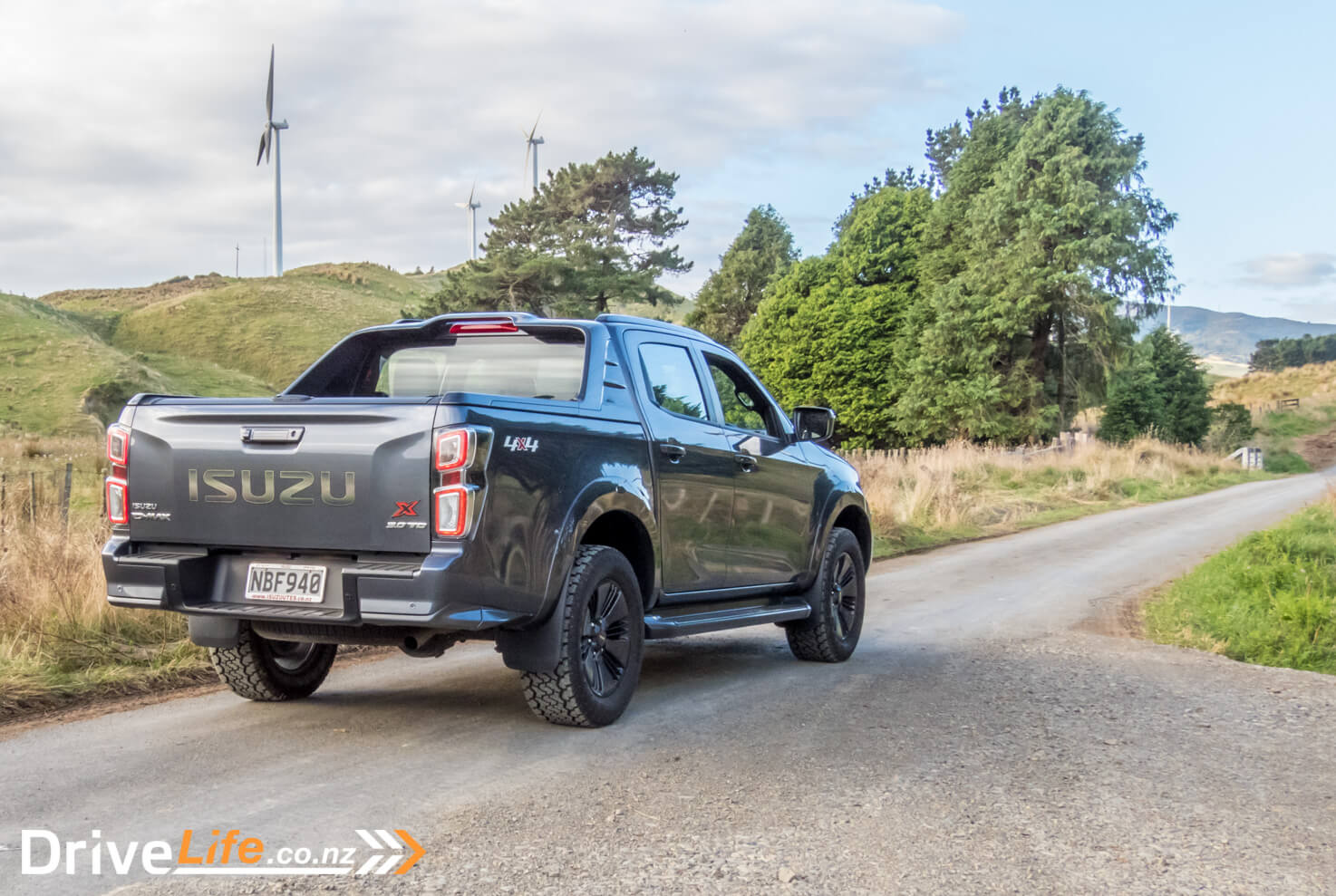
What’s The Competition For The 2021 Isuzu D-Max X-terrain?
| Brand/Model | Engine | Power (kW)/Torque (Nm) | Economy, L/100km (claimed) | Tow Rating, Kg (Unbraked/Braked) | Price (Highest to Lowest) |
| Volkswagen Amarok Aventura | 3-litre 6-cylinder turbo diesel | 190/580 | 9.5 | 750/3500 | $90,000 |
Ford Ranger Raptor | 2-litre 4-cylinder twin-turbo diesel | 157/500 | 8.2 | 750/2500 | $85,490 |
| Toyota Hilux Mako | 2.8-litre 4-cylinder turbodiesel | 150/500 | 7.9 | 750/3500 | $79,990 |
| Nissan Navara N-trek Warrior | 2.3-litre 4-cylinder twin-turbo diesel | 140/450 | 7.0 | 750/3500 | $76,990 |
| Isuzu D-Max X-terrain | 3-litre 4-cylinder turbodiesel | 140/450 | 8.0 | 750/3500 | $75,490 |
Ford Ranger Wildtrak | 2-litre 4-cylinder twin-turbo diesel | 157/500 | 8.2 | 750/2500 | $75,490 |
| Volkswagen Amarok Sportline | 3-litre 6-cylinder turbo diesel | 190/580 | 9.5 | 750/3500 | $75,000 |
| Mazda BT-50 Limited | 3-litre 4-cylinder turbodiesel | 140/450 | 8.0 | 750/3500 | $60,990 |
| Toyota Hilux SR5 Cruiser | 2.8-litre 4-cylinder turbodiesel | 150/500 | 7.9 | 750/3500 | $59,990 |
What’s The Pros And Cons For The 2021 Isuzu D-Max X-terrain?
Pros
- Engine performance
- Excellent fuel economy
- Smooth transmission
- Great exterior looks
Cons
- Too expensive; Can buy virtually the same vehicle for less
- Loud and intrusive safety technology
- Self-cancelling adaptive cruise
- Disconcerting handbrake feel
- No driver’s footrest
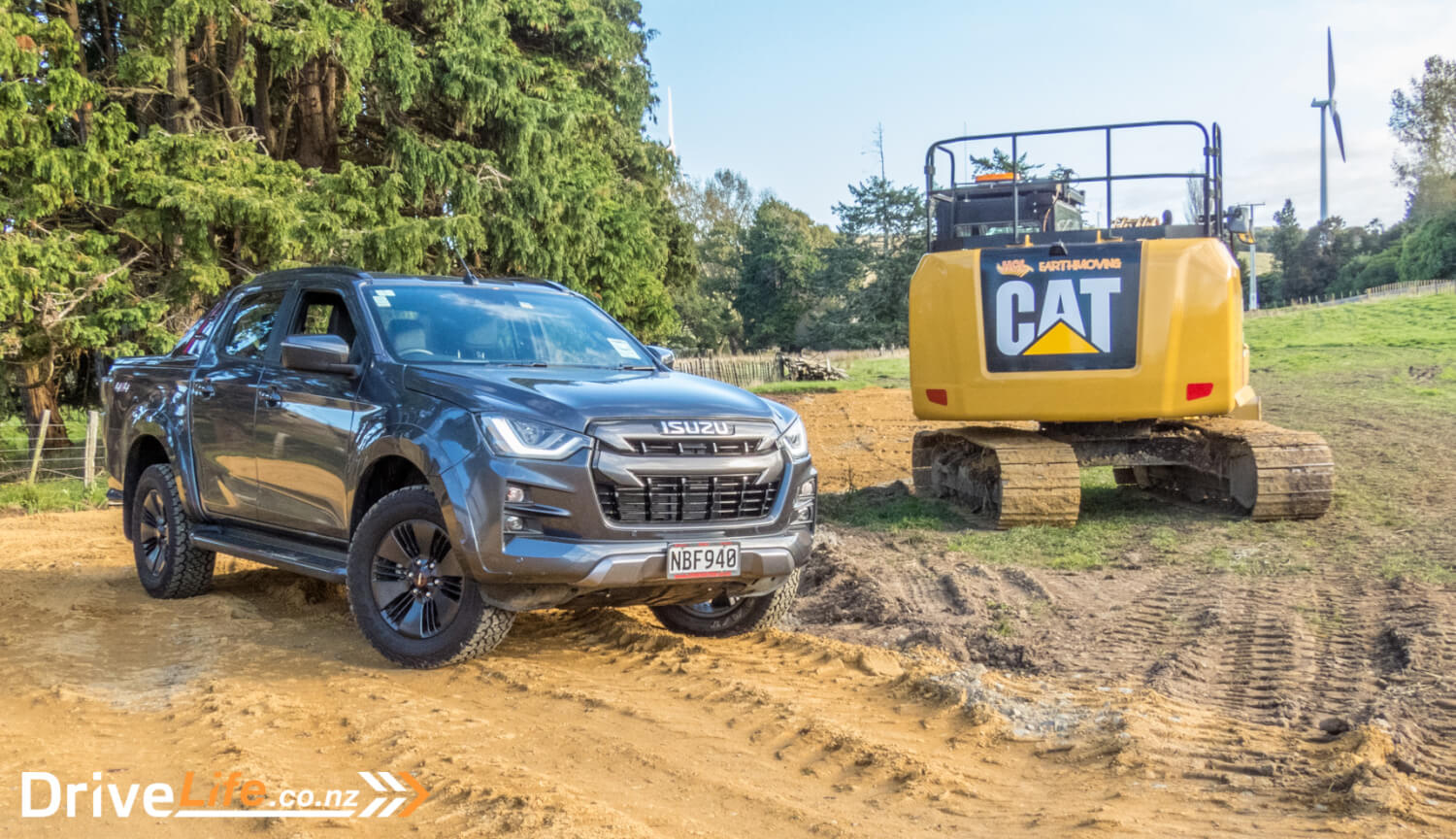
2021 Isuzu D-Max X-terrain – Specifications
| Vehicle Type | 5-door Double-cab Ute (4X4) |
| Starting Price | $75,490 |
| Price as Tested | $75,490 |
| Engine | 3-litre 4-cylinder turbo-diesel |
| Power, Torque (kW/Nm) | 140/450 |
| Transmission | 6-speed automatic |
| Spare Wheel | Full size (alloy) |
| Kerb Weight, Kg | 2,130 |
| Length x Width x Height (mm) | 5280 x 1880 x 1810 |
| Fuel tank Capacity, litres | 76 |
| Fuel Economy L/100km (Combined) | Advertised Spec – 8.0 Real World Test – 8.5 |
| Towing Capacity Kg, unbraked/braked | 750/3500 |
| Tray Payload | 970kg (Other models up to 1,320kg) |
| Maximum Wading Depth | 800mm |
| Approach Angle | 30.5o |
| Turning Circle | 12.5m Small: 6-10m / Medium 10-12m / Large 12m+ |
| Warranty | 3-year/100,000km Comprehensive Warranty 3-year/100,000km Roadside Assistance |
| ANCAP Safety Ratings | 5 Star |


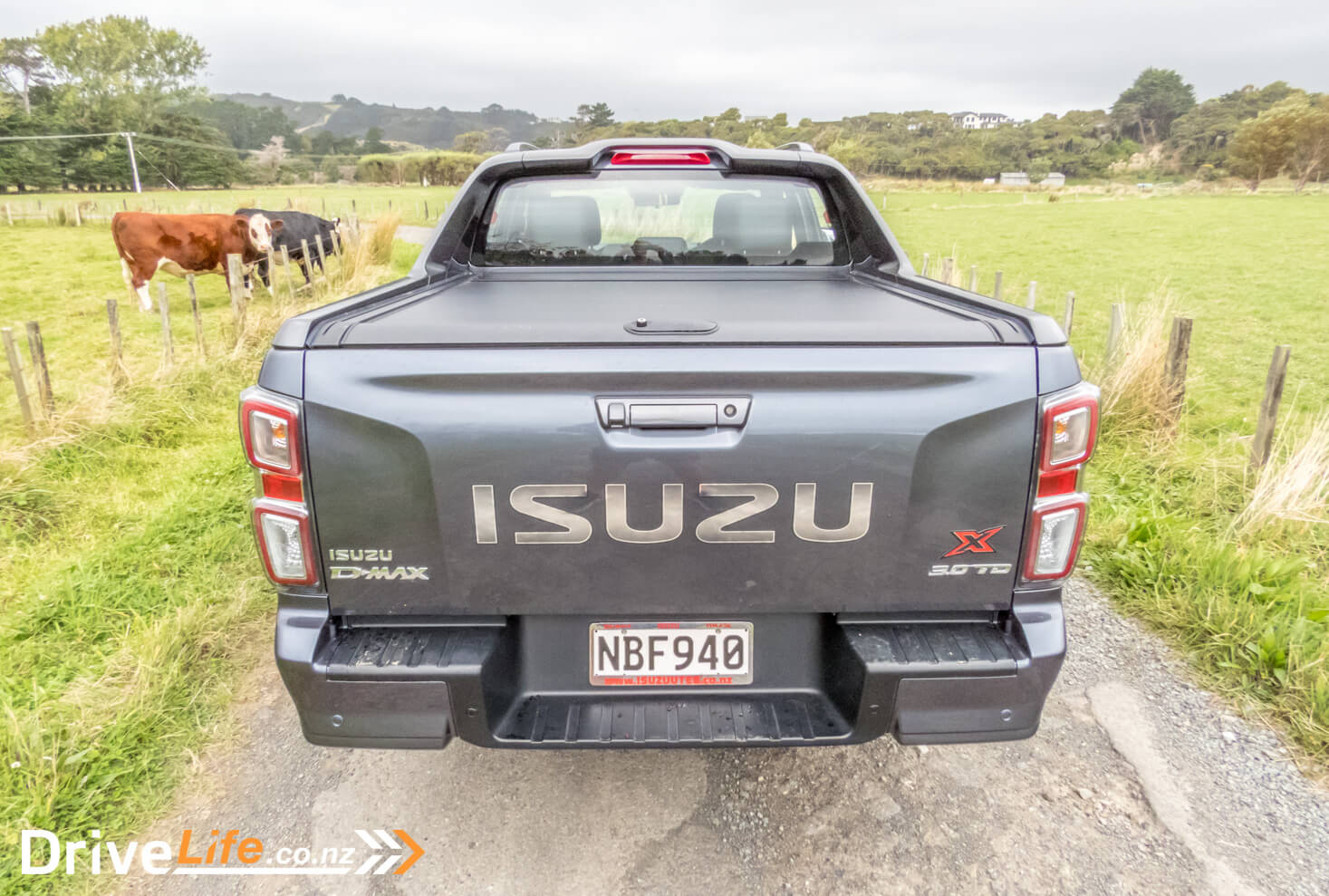












































I can’t find anywhere I can post feedback on a DMax, for potential to see. I bought the top of the range D Max 13 months ago, and after many conversations with sales people and the sales manager, I’ve just taken it back and told them to shove it! At 67 years old I’ve driven a lot of vehicles, this is the most unpleasant, unfit for purpose vehicle I’ve ever owned! There are so many sensors, that you can’t go off road without the vehicle beeping at every blade of long grass or post! If your a farmer this is not for you!!!